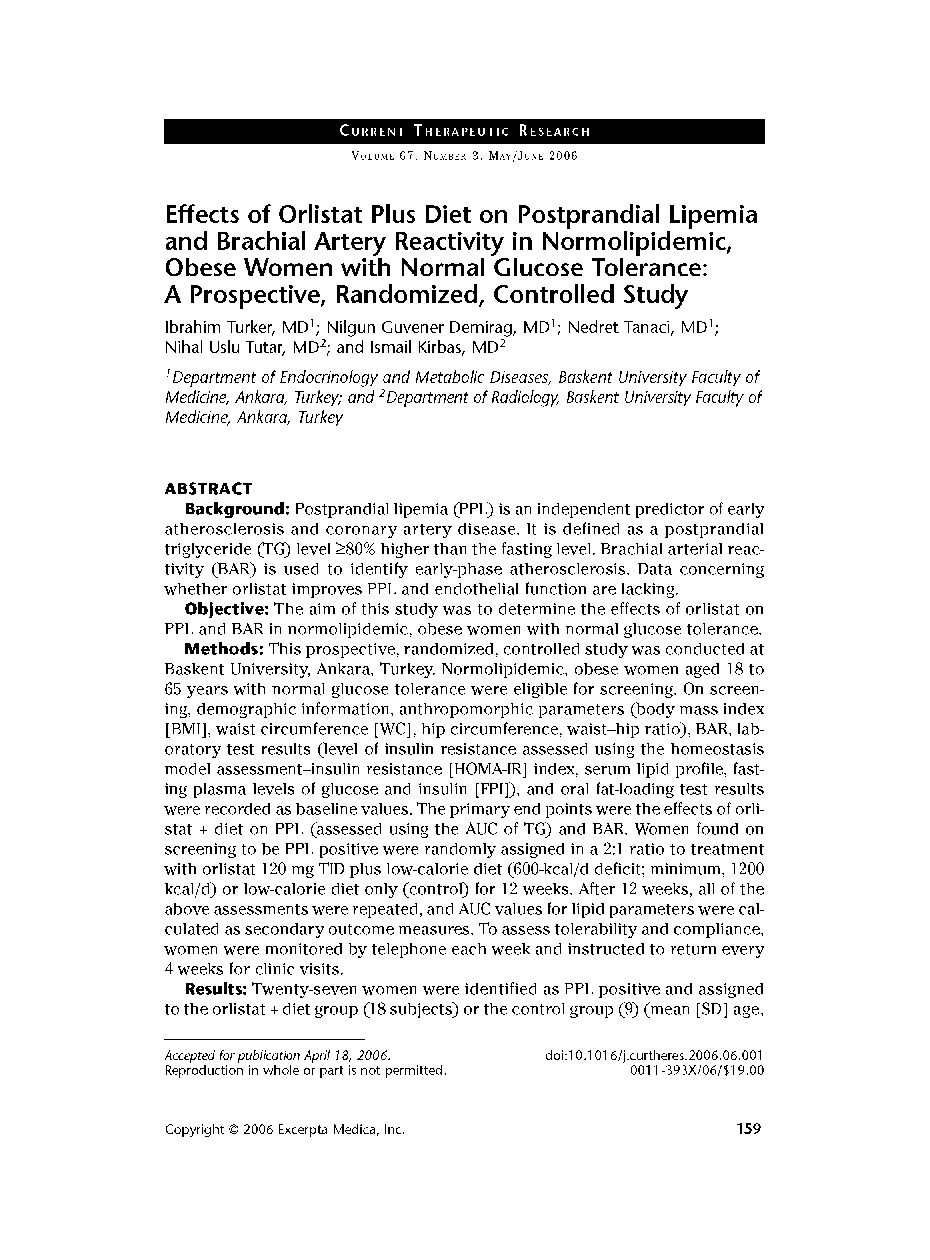| کد مقاله | کد نشریه | سال انتشار | مقاله انگلیسی | نسخه تمام متن |
|---|---|---|---|---|
| 4197085 | 1278748 | 2006 | 15 صفحه PDF | دانلود رایگان |

Background:Postprandial lipemia (PPL) is an independent predictor of earlyatherosclerosis and coronary artery disease. It is defined as a postprandial triglyceride (TG) level ≥80% higher than the fasting level. Brachial arterial reactivity (BAR) is used to identify early-phase atherosclerosis. Data concerning whether orlistat improves PPL and endothelial function are lacking.Objective:The aim of this study was to determine the effects of orlistat on PPL and BAR in normolipidemic, obese women with normal glucose tolerance.Methods:This prospective, randomized, controlled study was conducted at Baskent University, Ankara, Turkey. Normolipidemic, obese women aged 18 to 65 years with normal glucose tolerance were eligible for screening. On screening, demographic information, anthropomorphic parameters (body mass index [BMI], waist circumference [WC], hip circumference, waist-hip ratio), BAR, laboratory test results (level of insulin resistance assessed using the homeostasis model assessment-insulin resistance [HOMA-IR] index, serum lipid profile, fasting plasma levels of glucose and insulin [FPI]), and oral fat-loading test results were recorded as baseline values. The primary end points were the effects of orlistat + diet on PPL (assessed using the AUC of TG) and BAR. Women found on screening to be PPL positive were randomly assigned in a 2:1 ratio to treatment with orlistat 120 mg TID plus low-calorie diet (600-kcal/d deficit; minimum, 1200 kcal/d) or low-calorie diet only (control) for 12 weeks. After 12 weeks, all of the above assessments were repeated, and AUC values for lipid parameters were calculated as secondary outcome measures. To assess tolerability and compliance, women were monitored by telephone each week and instructed to return every 4 weeks for clinic visits.Results:Twenty-seven women were identified as PPL positive and assigned to the orlistat + diet group (18 subjects) or the control group (9) (mean [SD] age, 45.9 [2.3] years; mean [SD] weight, 87.4 [2.5] kg; mean [SD] BMI, 36.0 [0.8] kg/m2). Treatment with orlistat + diet was associated with significantly greater changes from baseline compared with controls in WC (P= 0.003), fasting and postprandial serum TG levels (P = 0.012 and P < 0.001, respectively), FPI level (P = 0.001), and HOMA-IR index (P < 0.001). Logistic regression analysis found that 12 weeks of treatment with orlistat + diet was associated with a numeric, but statistically non-significant, 4.1-fold change in PPL, which was independent of reductions from baseline in weight and WC. Neither treatment was associated with significant changes from baseline in BAR. The prevalences of gastrointestinal symptoms previously found to be related to orlistat use were statistically similar between the orlistat + diet and control groups (9 [50.0%] vs 3 [33.3%] subjects).Conclusions:The results of this small study in normolipidemic, obesewomen with normal glucose tolerance suggest that 12 weeks of treatment with orlistat 120 mg/d plus low-calorie diet was associated with a numeric, but statistically nonsignificant, 4.1-fold change from baseline in PPL, which was independent of reductions from baseline in weight and WC. Treatment with orlistat + diet was associated with significant effects on WC, TG, and level of insulin resistance, but not BAR.
Journal: Current Therapeutic Research - Volume 67, Issue 3, May–June 2006, Pages 159-173